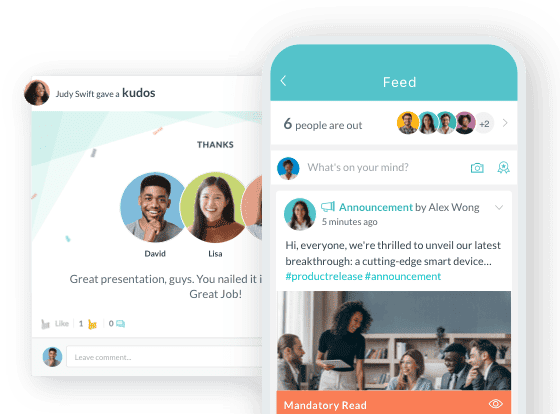Peer-to-Peer Recognition Programs: Implementation Guide with Templates
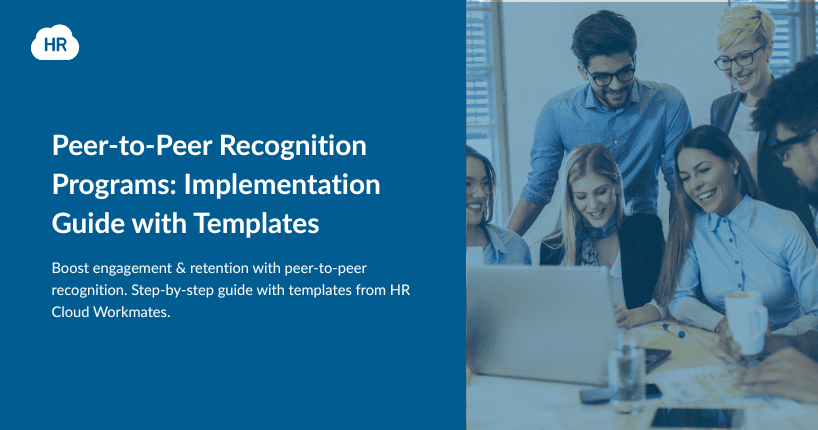
- What Is Peer-to-Peer Recognition — and Why It Matters
- Pre-Implementation Planning: Strategy and Foundation
- Platform and Tool Selection: What to Look For
- Implementation Roadmap and Timeline (With Templates)
- Best Practices and Tactics for Sustained Adoption
- Measurement, Analytics, and ROI
- Common Challenges and How to Overcome Them
- Sample Use Cases and Implementation Scenarios
- Templates and Resource Appendices
- Conclusion and Next Steps
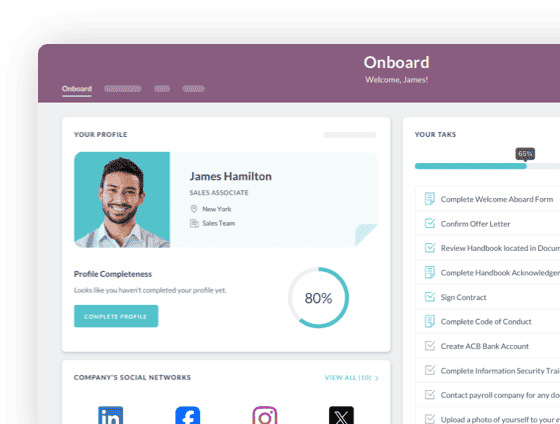
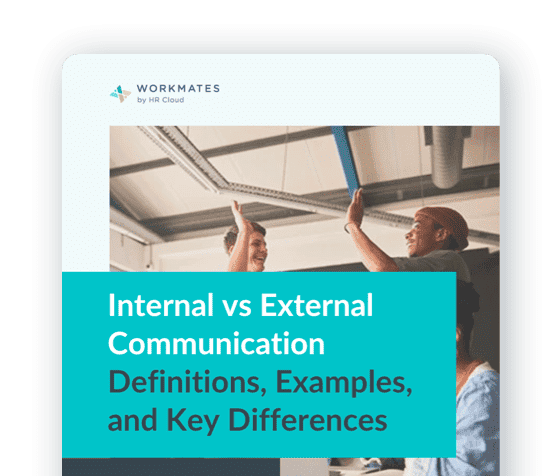
 Cut onboarding time
by 60%—here's the
Ultimate Checklist
that helped do it.
Cut onboarding time
by 60%—here's the
Ultimate Checklist
that helped do it.
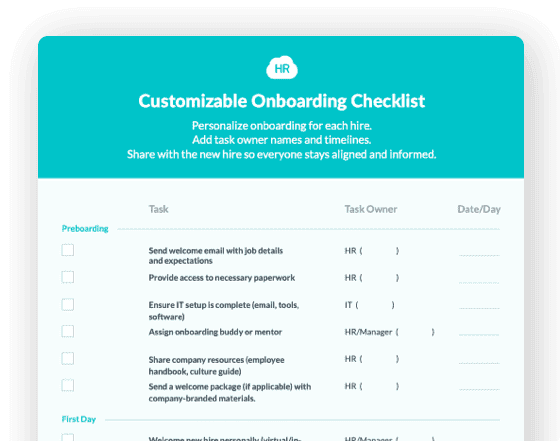
Peer-to-peer recognition transforms workplace culture by empowering employees to celebrate each other's contributions directly. Studies suggest companies with strong recognition programs may see 31% lower voluntary turnover and 23% higher profitability. This comprehensive guide provides a step-by-step framework for launching peer recognition initiatives, from planning and platform selection to measurement and sustained adoption. Included are ready-to-use templates for pilot launches, training, and recognition calendars that help organizations build authentic appreciation into daily workflows.
Introduction
"The best way to find yourself is to lose yourself in the service of others." Gandhi's words ring true in modern workplaces, but there's a twist: employees aren't just serving customers anymore. They're serving each other.
Picture this. Sarah stays late to help Marcus fix a critical bug before the client presentation. Marcus never forgets it. Two weeks later, he publicly recognizes Sarah's effort in the team channel, and suddenly, others start doing the same. Within months, the entire engineering department feels different—more connected, more willing to pitch in. That's peer-to-peer recognition at work.
Traditional top-down recognition has its place. Managers should absolutely acknowledge great work. But here's what most companies miss: your employees see things leadership doesn't. They witness the daily heroics, the quiet problem-solving, the person who always makes time to help a struggling colleague. When peers recognize peers, magic happens.
The numbers back this up. Research shows that peer recognition is 35.7% more likely to positively impact financial results than manager-only recognition. Companies implementing strong recognition programs report 31% lower voluntary turnover. And perhaps most compelling: 90% of employees say they're more likely to put in extra effort when their work gets noticed.
Yet many organizations struggle with implementation. They launch recognition programs with fanfare, only to watch participation fizzle after a few weeks. Recognition becomes forced, generic, or worse—completely forgotten. The gap between intention and execution remains frustratingly wide.
This guide changes that.
Key Takeaways
-
Peer recognition drives measurable business outcomes: Companies with effective programs see 31% lower turnover, 23% higher profitability, and employees who are 5x more likely to feel valued
-
Strategic planning separates success from failure: Define clear objectives, establish governance frameworks, and secure executive sponsorship before launching any recognition initiative
-
Platform selection requires careful evaluation: Integration capabilities, analytics depth, mobile accessibility, and customization options matter more than flashy features
-
Implementation follows a phased approach: Pilot programs identify issues early, full rollouts require comprehensive communication, and ongoing management prevents stagnation
-
Adoption demands intentional habit formation: Timely recognition, specificity in praise, leadership modeling, and gamification elements sustain long-term engagement
-
Measurement proves ROI and guides iteration: Track participation rates, sentiment scores, and correlation to business metrics while gathering qualitative feedback
What is Peer-to-Peer Recognition — and Why It Matters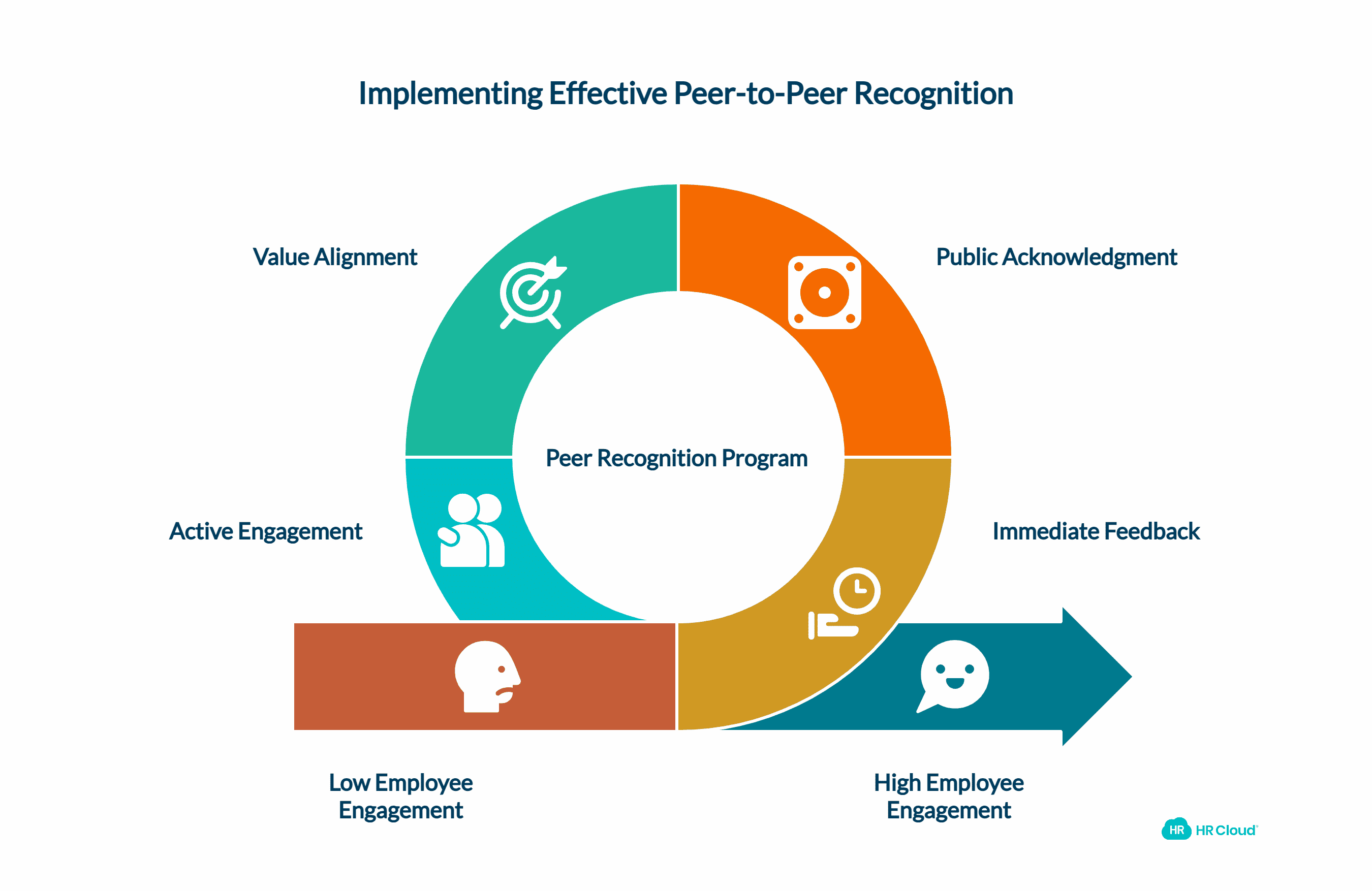
Defining the Concept
Peer-to-peer recognition flips the traditional appreciation model on its head. Instead of waiting for managers to notice accomplishments, employees directly acknowledge each other's contributions. Think of it as democratizing gratitude.
But it's more nuanced than just saying "thanks." True peer recognition creates structured pathways for colleagues to celebrate specific behaviors aligned with organizational values. It happens in real-time, appears publicly (when appropriate), and reinforces the culture you're building.
Unlike manager recognition, which often arrives during formal reviews, peer appreciation flows naturally through daily work. A developer helps troubleshoot code? Recognized immediately. A sales rep shares winning strategies? Acknowledged publicly. The accounts payable specialist processes invoices with remarkable accuracy. Celebrated by teammates who notice.
This differs from traditional reward programs focused on tenure milestones or top performers. Peer recognition celebrates everyone's contributions—the project manager who kept everyone calm during a crisis, the junior associate who asked the question nobody else would, the operations specialist whose attention to detail prevented a costly error.
Core Benefits Backed by Science
The evidence for peer recognition's impact keeps mounting. Organizations with high employee engagement levels are 23% more profitable, experience 18% higher productivity, 78% lower absenteeism, and 21% lower turnover.
Here's what drives those numbers:
Engagement amplification: Employees who receive regular recognition are five times more likely to feel valued and appreciated, six times more likely to invest in their work, and seven times more likely to stay with their organization. That compound effect transforms workplace dynamics.
Retention improvement: 66% of employees say they would leave their job if they didn't feel appreciated. Peer recognition addresses this directly by making appreciation consistent and visible. When colleagues regularly acknowledge each other, belonging strengthens and departure rates drop.
Performance enhancement: Gartner research suggests peer feedback can enhance performance by as much as 14%. Behavioral reinforcement works. When specific actions get celebrated immediately, those actions repeat.
Cultural alignment: Recognition tied to company values reinforces those values organically. Employees learn what matters by seeing what gets celebrated. Over time, this shapes behavior more effectively than any poster campaign or training module.
The Behavioral Science Lens
Why does peer recognition work so powerfully? Behavioral psychology provides answers.
Immediate feedback loops: The brain responds strongest to immediate reinforcement. When Sarah recognizes Marcus within minutes of his helpful action, Marcus's brain creates a stronger association between "helping" and "positive outcome" than any quarterly review could generate.
Social proof dynamics: Humans are fundamentally social creatures. When we see peers being recognized for certain behaviors, we unconsciously model those behaviors. Public recognition creates virtuous cycles where positive actions spread through teams like cultural contagions.
Intrinsic motivation activation: 67% of employees rated praise and commendation as the top motivators for performance, choosing them over performance bonuses and other financial incentives. Peer recognition taps into intrinsic motivators—mastery, autonomy, purpose—more effectively than monetary rewards.
Habit formation mechanisms: Recognition creates trigger-action-reward patterns that build habits. When giving and receiving recognition becomes routine, appreciation embeds itself into organizational muscle memory.
Pitfalls and Misconceptions
Not all recognition programs succeed. Understanding what derails them matters as much as knowing what works.
Forced praise syndrome: Mandating recognition kills authenticity. When employees must recognize someone each week regardless of circumstances, appreciation becomes transactional and meaningless. Genuine recognition flows from actual observation of valuable contributions.
Recognition fatigue: Too much recognition dilutes impact. If everyone gets praised for everything constantly, recognition loses meaning. Strategic programs balance frequency with significance.
Inequality and visibility bias: Some roles naturally generate more visible achievements. Sales closes deals publicly; IT prevents problems nobody sees. Effective programs actively address this imbalance by creating recognition pathways for all contribution types.
The participation gap: Studies show nearly 30% of workers haven't received recognition for strong work in over a year, if at all. Passive systems fail. Active engagement strategies—champion networks, manager training, regular prompts—close this gap.
Ready to build a recognition program that actually works? Schedule a demo to see how Workmates transforms peer appreciation into measurable business results.
Pre-Implementation Planning: Strategy and Foundation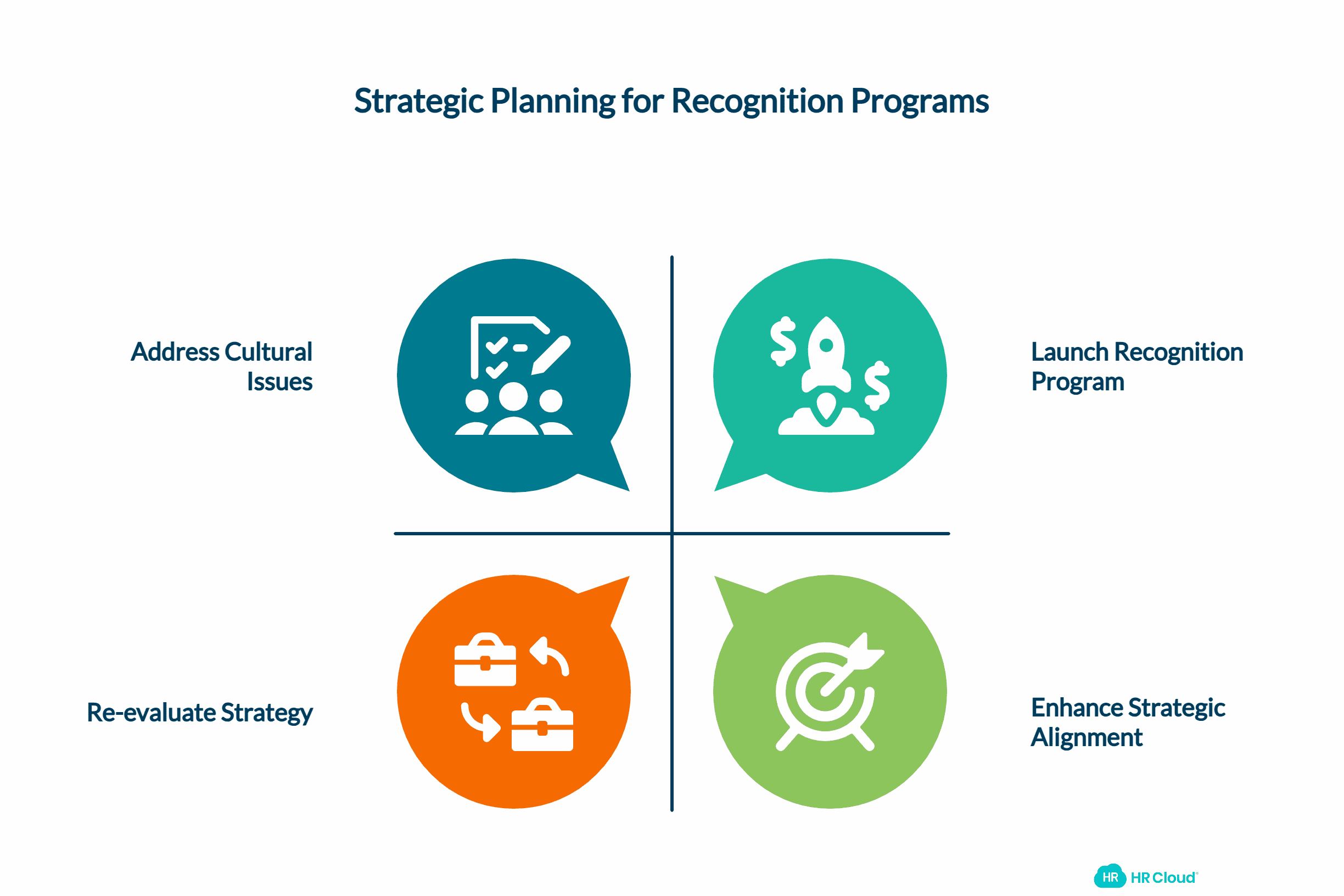
Diagnosing Your Cultural Readiness
Before launching any recognition program, assess your current state honestly. Some organizations aren't ready for peer-to-peer recognition because foundational elements remain missing.
Ask yourself: Do employees generally trust each other? Is collaboration rewarded or do competitive dynamics dominate? Can people give feedback without fear of retaliation? Do managers model appreciation themselves?
If your culture skews heavily political, recognition programs can backfire. Employees might use recognition strategically rather than authentically. Address underlying cultural issues first, then introduce recognition.
Signs of readiness include existing informal recognition (people already thank each other), collaborative rather than competitive dynamics, psychological safety (people speak up without fear), and leadership support for employee-driven initiatives.
Consider running a brief cultural assessment. Survey employees about current recognition frequency, comfort with peer feedback, and perceived fairness in how contributions get acknowledged. The data reveals whether you're building on solid ground or shaky foundations.
Defining Clear Objectives and KPIs
Vague goals doom recognition programs. "Improve culture" sounds nice but means nothing operationally. Effective programs define specific, measurable objectives upfront.
What are you actually trying to achieve? Common objectives include:
-
Increase employee engagement scores by a specific percentage
-
Reduce voluntary turnover in targeted departments
-
Strengthen cross-functional collaboration
-
Reinforce specific organizational values
-
Improve new hire integration and belonging
-
Boost productivity metrics in key areas
Each objective requires corresponding KPIs. If you're targeting engagement, measure recognition participation rate (percentage giving and receiving), recognition frequency (recognitions per employee per month), sentiment in recognition messages, and correlation between recognition frequency and engagement survey scores.
For retention goals, track turnover among frequent recognition recipients versus non-recipients, exit interview mentions of recognition (or lack thereof), and retention rate changes in high-recognition teams versus low-recognition teams.
Establish baseline metrics before launch. You can't prove improvement without knowing where you started.
Governance, Guardrails, and Recognition Etiquette
Left completely unstructured, recognition programs drift toward extremes—either unused or abused. Smart governance creates helpful guardrails without stifling spontaneity.
Timeliness standards: Encourage recognition within 24-48 hours of the observed behavior. Immediate appreciation carries more weight and reinforces actions more effectively.
Specificity requirements: Generic "great job" messages add little value. Establish norms around specific recognition that names the action, explains the impact, and connects to organizational values.
Inclusivity guidelines: Recognition should flow to all roles and levels. Create prompts that help people recognize contributions from less visible positions. Maintenance staff who keep facilities running smoothly deserve recognition as much as sales teams who close big deals.
Frequency balance: Neither too rare nor too common. Weekly recognition feels right for most teams. Daily might overwhelm; monthly allows too much time between reinforcements.
Public versus private decisions: Some recognition works best publicly (celebrating project wins), other moments deserve privacy (helping a struggling colleague). Empower employees to choose based on context.
Anti-gaming measures: Point systems can incentivize gaming. Cap recognition giving per employee per period, vary point values, and requires written messages beyond just clicking badges.
Budgeting and Resource Planning
Recognition programs cost money. Not as much as replacing departed employees, but real costs nonetheless.
Platform costs vary widely. Simple systems start around $2-3 per employee monthly. Comprehensive platforms with rewards catalogs, advanced analytics, and full HRIS integration run $5-8 per employee monthly. Enterprise solutions with white-labeling and dedicated support reach $10-15 per employee monthly.
Beyond platforms, budget for rewards and redemption. Many organizations allocate $25-100 per employee annually for redeemable recognition points. This creates tangible appreciation beyond digital kudos.
Training investments matter too. Plan for manager workshops, employee orientation sessions, and ongoing education about effective recognition practices. Internal communications support (videos, posters, email campaigns) amplifies adoption.
Administrative time represents hidden costs. Someone needs to manage the platform, analyze data, refresh campaigns, troubleshoot issues, and champion the program. Expect 0.25-0.5 FTE for organizations with 500-1000 employees.
Research shows companies that spend 1% or more of payroll on recognition have a 79% higher success rate in achieving business goals. That benchmark provides useful guidance.
Securing Stakeholder Alignment
Recognition programs fail without executive buy-in and manager sponsorship. Secure both before launching.
For executives, frame recognition as a strategic business initiative rather than HR program. Connect directly to retention costs, productivity metrics, and engagement survey gaps. Show the ROI calculations clearly.
Present the business case: "We're losing X employees quarterly at a replacement cost of $Y per person. Recognition programs correlate with Z% retention improvement. Here's the platform investment and expected payback period."
For managers, address their legitimate concerns. They're busy. Recognition might feel like another administrative burden. Show how platforms reduce their load by enabling peer-driven appreciation. Emphasize that recognition supplements rather than replaces their role.
Create a manager advisory group that helps shape the program. Co-creation builds ownership. These managers become champions who model recognition and encourage their teams.
Consider forming a cross-functional steering committee with representatives from various departments. This group guides implementation, addresses adoption barriers, and keeps the program evolving based on feedback.
Platform and Tool Selection: What to Look For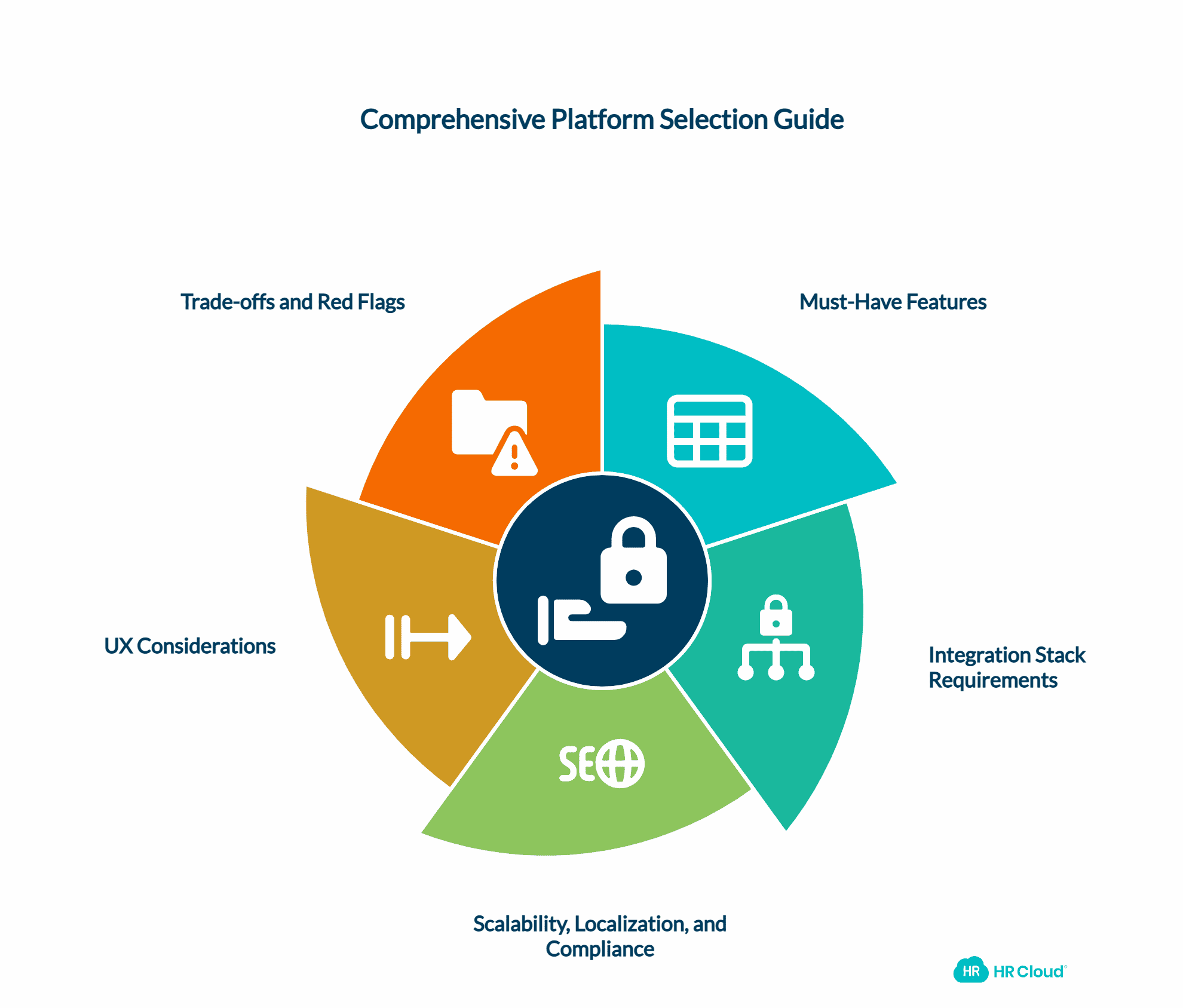
Must-Have Features
Platform selection shapes your program's success dramatically. Choose poorly, and you're fighting the tool constantly. Choose well, and technology amplifies your efforts invisibly.
Real-time recognition capabilities: The platform should enable instant appreciation. Employees shouldn't navigate complex workflows to give kudos. Mobile apps matter here—recognition happens wherever work happens.
Notification systems: When someone receives recognition, they should know immediately. Push notifications, email alerts, and integration with communication tools keep recognition visible and timely.
Analytics and reporting: This separates basic platforms from sophisticated ones. Look for dashboards showing participation rates across departments, recognition frequency trends over time, sentiment analysis of recognition messages, value alignment reporting, and individual versus team recognition patterns.
Reward catalogs and redemption: Digital kudos matter, but tangible rewards amplify impact. Comprehensive catalogs with gift cards, merchandise, experiences, and charitable donations provide meaningful choices.
Customization flexibility: Your recognition program should reflect your unique culture. Custom badges tied to company values, configurable point systems, branded interfaces, and adaptable workflows matter.
Social feeds and visibility: Public recognition creates cultural momentum. Central feeds where recognition appears prominently, commenting and reaction capabilities, spotlight features for standout recognition, and filtering options help employees engage.
Integration Stack Requirements
Standalone systems fail. Recognition platforms must integrate seamlessly into existing workflows and technology ecosystems.
HRIS integration: Your recognition platform should sync with your HR information system automatically. This ensures accurate employee data, eliminates manual updates, enables role-based recognition, and connects recognition to other HR processes.
Workmates by HR Cloud offers turnkey integrations with leading HRIS platforms, including ADP, UKG, Workday, Paycor, and Paylocity, ensuring seamless data synchronization across your entire HR technology stack.
Slack and Microsoft Teams connections: Most work communication happens in these platforms. Recognition should live there too. Look for native integrations allowing recognition without leaving these tools, notifications appearing in channels, and bot functionality for prompts and reminders.
Intranet embedding: Recognition feeds embedded in company intranets keep appreciation visible. Employees checking company news simultaneously see peer recognition flowing.
Mobile applications: Deskless workers and remote teams need mobile-first experiences. Full functionality through smartphones, offline capability for areas with poor connectivity, and push notifications ensure frontline employees participate fully.
Calendar integration: Automated milestone recognition (birthdays, work anniversaries) requires calendar connections that trigger celebrations without manual intervention.
Scalability, Localization, and Compliance
Today's platform choice must accommodate tomorrow's growth. Think ahead.
Scalability considerations: Will the platform handle growth from 100 to 1,000 employees smoothly? Does pricing scale reasonably? Can you add locations and departments easily? Does performance degrade with increased usage?
Localization capabilities: Global organizations need multi-language support, region-specific reward options, culturally appropriate recognition norms, and compliance with international data privacy regulations.
Compliance and security: Healthcare, financial services, and other regulated industries have specific requirements. Look for solutions with SOC 2 Type II certification, GDPR and CCPA compliance, role-based access controls, and detailed audit trail functionality to ensure robust security and regulatory alignment.
Workmates follows best-in-class security practices to keep sensitive internal data protected while enabling recognition across distributed teams.
UX Considerations
The best features mean nothing if nobody uses them because the interface frustrates.
Ease of giving recognition: Can employees give recognition in under 30 seconds? Are navigation and workflows intuitive? Does the mobile experience match desktop quality?
Ease of receiving recognition: Do recipients immediately understand their recognition? Can they respond gracefully? Is viewing recognition history simple?
Administrative burden: Can HR teams manage the platform without technical expertise? Are common tasks automated? Does reporting require manual data manipulation or does it generate insights automatically?
Accessibility standards: Does the platform meet WCAG requirements? Can employees with disabilities fully participate?
Trade-offs and Red Flags
No platform excels at everything. Understand trade-offs explicitly.
Rigid analytics: Some platforms offer beautiful dashboards that can't be customized. You're stuck with their predefined metrics. This limits deep analysis of what matters to your organization.
Limited customization: Template-based systems implement quickly but offer little flexibility. If your culture or values differ from standard templates, you'll compromise.
High friction processes: Multi-step approval workflows kill spontaneity. Recognition should flow freely, not through bureaucratic channels.
Vendor lock-in concerns: Can you export your recognition data easily? What happens if you switch platforms? Avoid systems that trap your historical data.
Inadequate support: Recognition platforms require ongoing support. Check response times, support channels, and whether you get dedicated account management or generic help desks.
Red flags include platforms with recent significant outages, companies with high customer churn, interfaces that haven't been updated recently, or vendors unable to provide customer references in your industry.
Why Workmates by HR Cloud Stands Out
Workmates centralizes recognition and engagement in one platform, making peer appreciation effortless while providing the analytics organizations need to measure impact.
The platform enables peer-to-peer kudos, points-based rewards, and custom badges that align with company values. Employees can celebrate each other's achievements instantly, whether through mobile apps or desktop interfaces.
What sets Workmates apart? Integration depth. The platform connects seamlessly with ADP, Paylocity, UKG, and other major HRIS systems, eliminating manual data entry and ensuring recognition programs stay current automatically.
For distributed teams, Workmates' mobile-first design ensures deskless workers and remote employees participate fully. Healthcare organizations particularly appreciate features designed for shift-based work environments.
User feedback consistently highlights ease of use. One client noted: "Our staff has praised the increased communications level Workmates delivers. We use it to communicate important project matters and give staff specific kudos."
Beyond basic recognition, Workmates provides robust analytics showing engagement trends, recognition activity patterns, and program ROI. This data-informed approach helps organizations continuously improve their recognition strategies.
The platform also addresses governance concerns that simpler tools miss. Customizable reward catalogs by team or location, approval workflows when needed, and audit trails provide the controls larger organizations require.
Workmates typically requires 2-4 weeks for full implementation, significantly faster than competitors' 8-12 week setup processes. This rapid deployment means faster time-to-value.
Curious how Workmates could transform recognition in your organization? Request a personalized demo to explore features tailored to your specific industry and team structure.
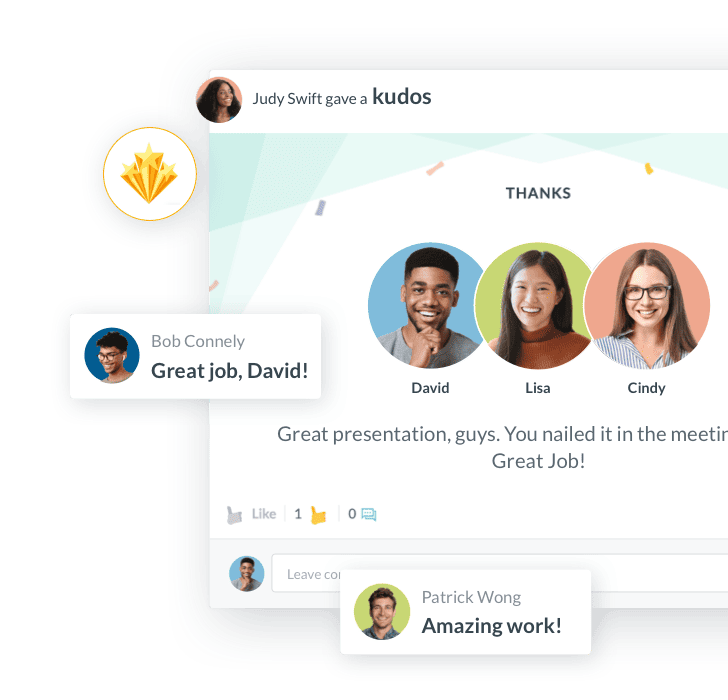
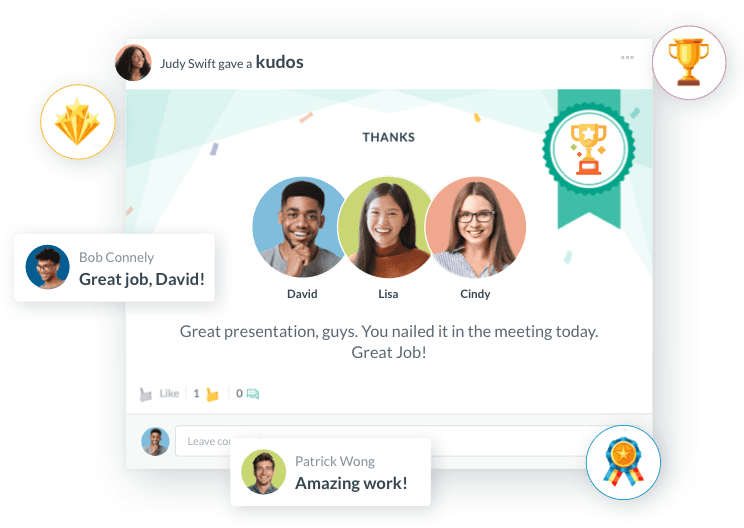
Implementation Roadmap and Timeline (With Templates)
Phase 0: Pilot vs Full Launch
The temptation to launch company-wide immediately is strong. Resist it. Pilots reveal issues before they become company-wide problems.
Smart pilots target specific characteristics. Choose 2-4 teams representing different departments (sales, engineering, operations, support), locations (if you're multi-site), team sizes (small teams behave differently than large ones), and management styles (enthusiastic champions versus skeptical managers).
This diversity surfaces varied perspectives and challenges. If the platform frustrates remote workers or confuses shift-based employees, you'll discover this during the pilot rather than after company-wide rollout.
Define success criteria explicitly. What would make you confident in full deployment? Common criteria include 70%+ of pilot participants giving at least one recognition, 80%+ reporting the experience as "easy" or "very easy", average recognition frequency of 2+ per employee per month, positive manager feedback on administrative burden, and measurable improvement in pilot team engagement scores.
Set a reasonable pilot duration—typically 4-8 weeks. Shorter periods don't allow habits to form. Longer periods delay broader rollout unnecessarily.
Phase 1: System Setup and Configuration
Technical configuration happens before anyone gives their first kudos. Get this foundation right.
Values mapping: Which organizational values will your recognition reinforce? Most companies have 4-7 core values. Create recognition badges or categories for each. If "innovation" matters, create an innovation badge. If "customer focus" drives decisions, make that recognizable.
Recognition categories: Beyond values, consider achievement types. Project completion, helping behaviors, going above and beyond, embodying culture, milestone achievements, and cross-functional collaboration all deserve acknowledgment.
Reward catalog curation: Points become meaningful when they unlock rewards people actually want. Survey employees about preferences. Gen Z might want streaming subscriptions; older employees might prefer restaurant gift cards. Diverse catalogs serve diverse teams.
Workflow design: Will recognition flow freely or require approval? Most programs succeed with open peer recognition and optional manager approval for point redemption above certain thresholds. This balances freedom with oversight.
Integration and authentication setup: SSO configuration ensures seamless access. HRIS sync keeps employee data current. Slack/Teams integration embeds recognition into existing workflows. Test thoroughly before launch.
Phase 2: Pilot Rollout
Launch your pilot with intention, not fanfare. Treat it as a learning opportunity rather than a permanent solution.
Selecting pilot teams: Beyond the diversity mentioned earlier, prioritize teams with engaged managers willing to champion the program. Early success creates momentum. Skeptical managers can join later rounds after proof points emerge.
Training and orientation: Everyone in the pilot needs clear understanding of recognition purpose, platform mechanics, recognition best practices, point values and reward options, and how to give and receive gracefully.
Training shouldn't overwhelm. 15-20 minute sessions work well. Show rather than tell—demonstrate giving recognition live. Address questions in real-time.
Communications plan: Announce the pilot with excitement but realistic expectations. "We're testing a new way to appreciate each other's contributions. You're in the first group helping us get it right. Share feedback honestly—we'll use it to improve."
Template A: Pilot Communication / Launch Email
Subject: You're invited: Help us test our new peer recognition program!
Hi [Pilot Team],
We're excited to announce that you've been selected to pilot Workmates Recognition—a new way for us to celebrate each other's contributions in real-time.
Why peer recognition?
Because you see the daily wins that leadership might miss. The colleague who stayed late to help meet a deadline. The team member whose attention to detail prevented a costly error. The person who made everyone laugh during a stressful week.
What's in it for you?
- Give kudos instantly via Slack, mobile app, or desktop
- Earn points redeemable for gift cards and rewards
- See recognition aligned with our company values
- Help shape the program before company-wide launch
Getting started:
1. Watch this 3-minute video: [link]
2. Log in here: [link]
3. Give your first recognition this week!
We're piloting this program for 6 weeks with your team and [X other teams]. Your honest feedback will help us improve before rolling out company-wide.
Quick training session scheduled for [date/time]—calendar invite coming separately.
Questions? Reply to this email or visit our FAQ page: [link]
Let's build a culture where appreciation flows freely!
[Your Name]
[Title]
Template B: Micro Training Slide Deck Tips
Slide 1: Welcome
-
Title: "Recognizing Each Other: Pilot Training"
-
Simple image of team celebrating
Slide 2: Why This Matters
-
Bullet points on recognition impact
-
Include 1-2 compelling statistics
-
Keep it brief
Slide 3: What You Can Recognize
-
Examples of recognition-worthy moments
-
Connect to company values
-
Emphasize "everyday wins" not just major achievements
Slide 4: How to Give Great Recognition
-
Be specific (what they did)
-
Explain impact (why it mattered)
-
Be timely (within 24-48 hours)
-
Example of good vs. generic recognition
Slide 5: Platform Demo
-
Live walkthrough of giving recognition
-
Show mobile and desktop versions
-
Emphasize how easy it is
Slide 6: Points and Rewards
-
Explain point values
-
Show reward catalog highlights
-
Redemption process
Slide 7: Your Role in the Pilot
-
Try giving recognition this week
-
Explore the platform
-
Complete our 2-minute feedback survey
-
Ask questions in #recognition-pilot channel
Slide 8: Q&A
-
Open floor for questions
Feedback surveys and iteration: Check in regularly during the pilot. Weekly pulse surveys (2-3 questions) reveal emerging issues quickly. Mid-pilot focus groups provide qualitative insights. End-of-pilot comprehensive surveys guide refinements.
Ask about ease of use, frequency of recognition giving and receiving, relevance of reward options, integration with daily workflow, what features they love, and what frustrates them.
Use this feedback immediately. If mobile app navigation confuses people, improve it before full rollout. If point values feel arbitrary, adjust them. Iteration during pilots prevents company-wide frustration.
Phase 3: Full-Scale Rollout
Pilot success validated your approach. Now scale carefully.
Communications blitz: Recognition programs thrive on visibility. Launch with multi-channel communications that include an executive video message explaining why recognition matters, email series introducing features and benefits, intranet articles featuring pilot team experiences, posters in physical locations, and Slack/Teams announcements and reminders.
Don't front-load everything. Spread communications over 2-3 weeks to maintain attention without overwhelming.
Launch rituals: Create memorable moments around launch. Consider "Recognition Week" where a company-wide kick-off event, daily recognition challenges, leadership modeling appreciation, and recognition milestones get celebrated.
Some organizations designate "Recognition Fridays" where teams dedicate 10 minutes to giving kudos. Others create monthly themes highlighting different values or contribution types.
Template C: Recognition Calendar / Ritual Planner
Recognition Program Annual Calendar
Q1: Launch & Establish Habits
- Week 1: Company-wide kick-off, leadership video
- Week 2-3: Department training sessions
- Week 4: "Recognition Week" challenge (goal: everyone gives at least one)
- Month 2: "Value Spotlight" (highlight one value weekly)
- Month 3: First milestone celebration (X recognitions given!)
Q2: Deepen Engagement
- Month 4: Cross-functional recognition campaign
- Month 5: Manager appreciation focus
- Month 6: Mid-year recognition awards ceremony
Q3: Refresh & Expand
- Month 7: New reward options launch
- Month 8: Recognition best practices refresh training
- Month 9: Quarterly recognition report sharing
Q4: Celebrate & Plan
- Month 10: Anniversary milestone celebration
- Month 11: Year-end recognition blitz
- Month 12: Annual recognition awards, plan next year
Monthly Rituals:
- First Monday: Recognition tip in company newsletter
- Every Friday: #RecognitionFriday posts in main channel
- Last Thursday: Monthly recognition leaderboard (celebrate top givers AND receivers)
Weekly Rituals:
- Mondays: "Motivation Monday" prompt (Who motivated you last week?)
- Wednesdays: Value-specific prompt (Who exemplified [Value] this week?)
- Fridays: Weekend wrap-up (What wins should we celebrate?)
Champion networks: Identify natural evangelists—employees who embrace recognition enthusiastically during pilots or early adoption. Train them as ambassadors who answer questions, share success stories, encourage teammates, and provide feedback to program administrators.
Give champions special status. Recognition badges, early access to new features, or involvement in program evolution decisions all work. Their peer influence matters more than top-down mandates.
Phase 4: Ongoing Management and Iteration
Launch doesn't end the work—it begins it. Sustained programs require active management.
Monitoring KPIs and dashboards: Check metrics weekly initially, then bi-weekly once stabilized. Watch for participation drops, departments falling behind, recognition clustering (few people receiving most recognition), and point redemption patterns.
Set alerts for concerning trends. If company-wide participation drops below 60% or a department shows three consecutive weeks of declining recognition, investigate immediately.
Monthly or quarterly review cycles: Establish rhythm for deeper analysis. Monthly reviews examine department comparisons, value alignment, recognition quality (specific versus generic), and reward catalog utilization.
Quarterly reviews step back further to assess correlation with engagement surveys, impact on retention metrics, manager effectiveness at fostering recognition, and whether recognition patterns align with stated priorities.
Refresh campaigns and spotlight stories: Recognition programs grow stale without periodic rejuvenation. Every 8-12 weeks, launch refresh campaigns with new themes, updated reward options, spotlight recognition stories, and gamification elements.
Feature real recognition stories prominently. "Sarah recognized Marcus for staying late to help with the client presentation. Marcus says this recognition reminded him why he loves working here. Small moments create big impact."
Dealing with stagnation, drop in usage, or misuse: Even well-designed programs hit rough patches. Common issues include participation fatigue (initial enthusiasm wanes), manager neglect (busy managers stop encouraging recognition), technical friction (platform updates introduce bugs), and recognition inflation (too much generic praise).
Address stagnation proactively. Introduce new recognition categories tied to current business initiatives. Launch friendly competition between departments. Refresh reward options. Survey employees about what would re-energize them.
For serious misuse—gaming the system, inappropriate recognition, or recognition harassment—address quickly and transparently. Clear guidelines and swift responses maintain program integrity.
Best Practices and Tactics for Sustained Adoption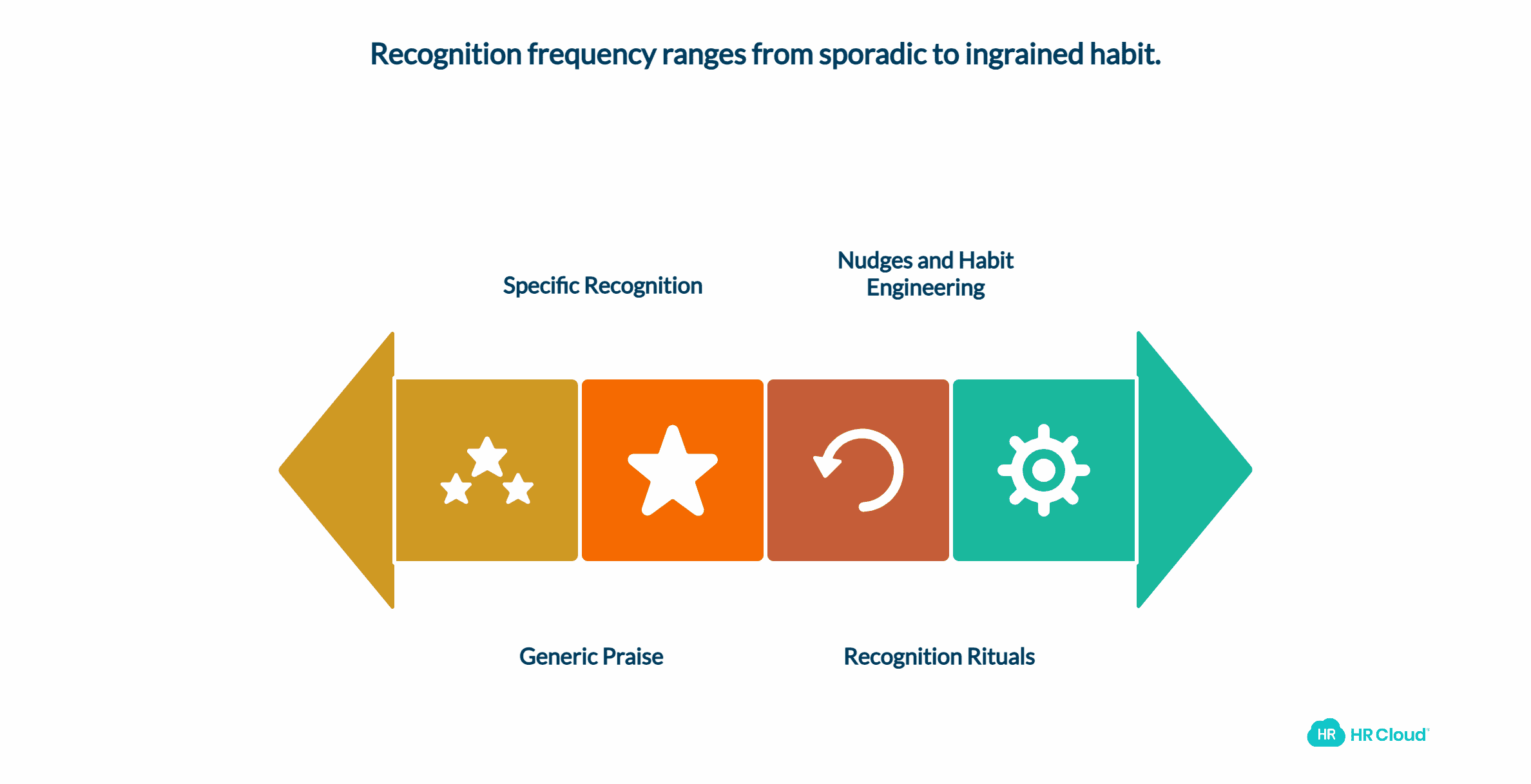
Encourage Frequent, Timely, and Specific Recognition
Generic praise disappears quickly. Specific recognition creates lasting impact and teachable moments.
Instead of "Great job on the project," effective recognition says: "Your detailed analysis of customer feedback in the Q3 project identified issues we would've missed. This saved us significant rework time and improved our final deliverable. Thank you for your thorough attention to detail."
That specificity accomplishes multiple goals. The recipient understands exactly what they did well, creating a roadmap for future success. Others reading the recognition learn what good analysis looks like. The behavior gets reinforced behaviorally and socially.
Specificity matters deeply—employees who receive specific recognition are more likely to repeat positive behaviors than those receiving generic praise.
Timeliness matters equally. Recognition loses potency over time. The connection between action and appreciation weakens when weeks pass. Encourage recognition within 24-48 hours of the observed behavior.
Build prompts that trigger timely recognition. "Who helped you solve a problem this week?" "What colleague went above and beyond today?" These nudges convert observations into action.
Promote Inclusivity and Equity
Some roles generate visible achievements naturally. Sales closes deals. Product ships features. But what about the facilities manager who keeps offices running smoothly? The HR generalist handling benefits questions patiently? The accountant whose accuracy prevents errors?
Intentional inclusivity ensures all contributions get acknowledged.
Create recognition campaigns highlighting less visible roles. "Operations Excellence Week" spotlights support functions. "Unsung Heroes" campaigns specifically ask employees to recognize colleagues whose work often goes unnoticed.
Track recognition distribution analytics. If certain departments or roles receive disproportionately less recognition, investigate why. Sometimes it reflects genuine performance issues. More often, it reveals visibility bias requiring correction.
Encourage cross-functional recognition specifically. When engineering recognizes finance, or sales acknowledges operations, organizational silos weaken. Create prompts facilitating this: "Who from another department made your work easier this month?"
Recognition Rituals and Gamification
Habits form through repetition and structure. Recognition rituals transform sporadic appreciation into cultural practice.
Weekly team meetings that allocate 5-10 minutes for recognition shout-outs normalize appreciation. Make it routine rather than special. When recognition becomes expected, participation increases.
"Recognition Fridays" create anticipation. Employees know Friday afternoon means acknowledging the week's contributions. Some organizations use "Monday Motivation" instead, starting the week by celebrating the previous week's wins.
Gamification adds engagement layers without trivializing recognition. Leaderboards showing top recognition givers (not just receivers) celebrate generosity. Badges for recognition milestones—"You've given 50 recognitions!"—create achievement goals.
Points-based systems that unlock rewards increase participation by 40%, making recognition tangible beyond digital acknowledgment.
Recognition walls—physical or digital spaces showcasing recent appreciation—maintain visibility. Digital signage in offices displaying recognition feeds keeps appreciation top-of-mind for deskless workers.
But avoid gamification pitfalls. Competition between receivers creates destructive dynamics. Mandatory recognition quotas feel forced. Balance playful elements with authentic appreciation.
Leadership and Manager Modeling
72% of employees say recognition from their manager has the most impact on their engagement. Managers set recognition tone for entire teams.
When leaders recognize peers—not just direct reports—they demonstrate that appreciation transcends hierarchy. The CEO recognizing an entry-level employee's contribution carries enormous symbolic weight.
Train managers explicitly on recognition best practices. Only 22% of managers report feeling equipped to understand how to acknowledge employees. Don't assume they know how.
Manager training should cover why recognition matters (business impact, not just feel-good), how to give effective recognition (specific, timely, values-aligned), encouraging peer recognition on their teams, addressing low participation, and avoiding recognition favoritism.
Hold managers accountable through metrics. Include recognition activity in performance reviews. Track whether their teams participate actively. Celebrate managers whose teams show strong recognition cultures.
Recognition at Scale: Cohorts, Cross-Team Appreciation, and Ambassadors
Small teams adopt recognition easily. Scaling to hundreds or thousands of employees requires different strategies.
Cohort-based approaches work well. Group employees by join date, role type, or location. Create cohort-specific recognition challenges. New hire cohorts might focus on acknowledging mentors. Leadership cohorts might emphasize recognizing frontline contributions.
Cross-team appreciation strengthens organizational cohesion. When marketing recognizes a product's responsiveness, or operations acknowledges sales' clear communication, interdepartmental respect grows. Facilitate this through prompts, spotlights, and incentives.
Ambassador networks scale recognition championing. Rather than one person evangelizing company-wide, distribute responsibility across representatives from each department. These ambassadors drive local adoption, gather feedback, share best practices, and maintain energy.
Give ambassadors resources—talking points, mini-budgets for team recognition events, direct access to program administrators. Meet with them quarterly to share insights and adjust strategies.
Avoiding Pitfalls: Mandatory Recognition, Inflation, and Bias
Well-intentioned programs derail through predictable mistakes. Watch for these traps.
Mandatory recognition: Requiring employees to give X recognition weekly destroys authenticity. Recognition should flow from genuine observation, not obligation. Encourage frequency without mandating it.
Recognition inflation: When everyone gets praised constantly for everything, recognition loses meaning. Like grade inflation, appreciation inflation devalues currency. Maintain standards around recognition-worthy contributions.
Hidden bias: Unconscious bias affects recognition patterns. Extroverts might receive more recognition than introverted contributors. Certain demographics might get acknowledged more frequently. Monitor data for bias signals and address through training and intentional campaigns.
Recency bias: Teams tend to recognize recent contributions while forgetting earlier work. Prompts addressing this help: "Thinking back over the quarter, whose earlier contribution deserves recognition?"
Proximity bias: Remote workers often receive less recognition than office-based employees. Distributed teams need intentional inclusion strategies ensuring distance doesn't equal invisibility.
Nudges and Habit Engineering
Behavioral economics offers tools for increasing recognition frequency without mandates.
Default settings matter: Make recognition highly visible by default. Opt-out rather than opt-in approaches increase participation. Recognition feeds appearing prominently on intranets rather than buried in menus drive engagement.
Strategic reminders: Weekly email nudges with recognition prompts—"Who helped you overcome a challenge this week?"—trigger action. Time these strategically. Monday mornings prompt weekend reflection. Thursday afternoons catch end-of-week accomplishments.
Reducing friction: Every extra click reduces completion rates. Streamline recognition to absolute minimum steps. Mobile apps should enable recognition in under 30 seconds.
Social proof: Showcasing recognition activity creates bandwagon effects. "Your team gave 47 recognitions this week—up from 39 last week!" Messages like these leverage comparison and momentum.
Loss aversion: Framing around potential losses motivates more than equivalent gains. "Don't let this week's wins go unrecognized" works better than "Recognize someone this week."
Commitment devices: Public commitments increase follow-through. Managers who announce intentions to recognize team members weekly follow through at higher rates than those keeping goals private.
Celebrating Small Wins and Spotlight Moments
Recognition programs generate stories worth amplifying. Feature these prominently in internal newsletters, intranet spotlights, all-hands meetings, and leadership communications.
Real stories humanize recognition and model desired behaviors. Share narratives like: "When the client presentation system crashed 10 minutes before the meeting, Marcus immediately jumped in to troubleshoot while Sarah restructured the presentation for backup delivery. Their quick thinking saved the account. This exemplifies our 'Resilience' value perfectly."
Monthly or quarterly recognition awards ceremony—virtual or in-person—create anticipation and celebration. Categories might include most recognitions given, most cross-functional recognition, best embodiment of specific values, or most improved team recognition culture.
But avoid over-formalizing. Recognition shouldn't feel like another corporate program. Balance structure with spontaneity, celebration with authenticity.
Building sustainable recognition habits requires the right platform foundation. Explore how Workmates makes giving and receiving recognition effortless while providing the analytics you need to measure cultural transformation.
Measurement, Analytics, and ROI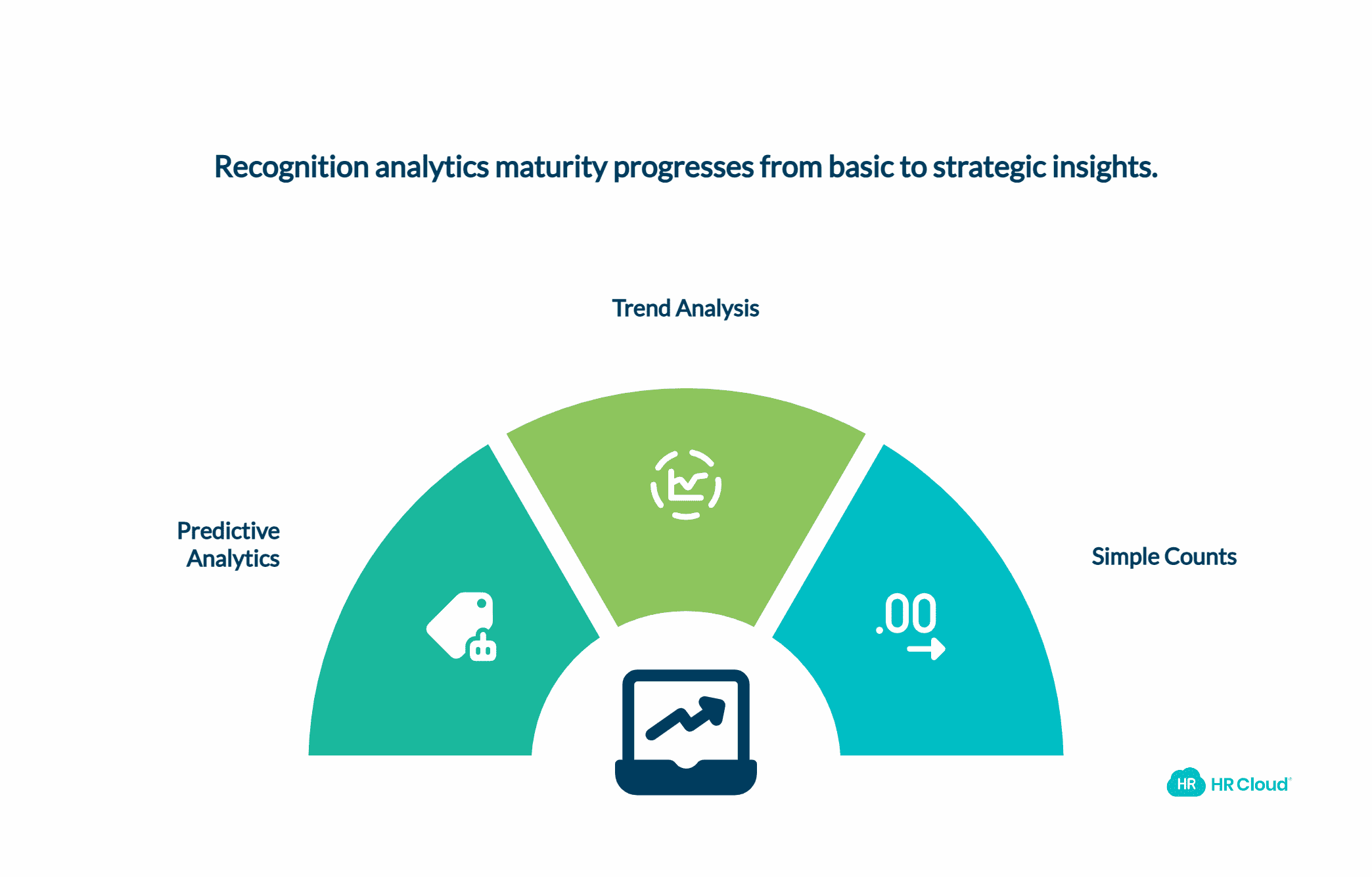
Core Metrics to Track
What gets measured gets managed. Recognition programs require rigorous metrics proving value and guiding improvement.
Participation metrics: The most fundamental measures include percentage of employees giving at least one recognition (target: 70-80%), percentage receiving at least one recognition (target: 60-70%), recognitions per employee per month (target: 2-4), and distribution across departments and roles.
Low giving rates suggest engagement issues. Low receiving rates indicate inequitable distribution. Both require intervention.
Frequency and consistency: Beyond absolute numbers, track trends over time. Is recognition increasing, stable, or declining? Do certain weeks show spikes (post-training) or valleys (during busy periods)?
Consistency matters more than occasional peaks. Programs sustaining 3-4 recognitions per employee monthly outperform those with erratic patterns.
Recognition quality metrics: Not all recognition carries equal weight. Analyze message length (longer typically indicates more thoughtful recognition), specificity (generic versus detailed), value alignment (recognition tied to company values), and response rates (do people engage with recognition they receive?).
Sentiment analysis: Advanced platforms use natural language processing to assess recognition sentiment. Are messages genuinely positive? Do they reflect authentic appreciation or perfunctory compliance?
Redemption rates: Track what percentage of earned points get redeemed, average time between earning and redemption, and which rewards prove most popular. Low redemption suggests poor reward catalog fit.
Repeat behavior: Are the same people giving most recognition while others never participate? Are recognition patterns reciprocal or one-directional? Healthy programs show broad participation rather than concentration.
Qualitative Feedback
Numbers reveal patterns but miss nuance. Qualitative feedback provides context.
Conduct quarterly focus groups with diverse employee samples. Ask open-ended questions: What do you value most about our recognition program? What frustrates you? How has recognition affected your experience here? What would make you recognize colleagues more frequently?
These conversations surface issues metrics miss—unclear value definitions, technical frustrations, cultural barriers, or unexpected benefits.
Anonymous surveys complement focus groups by enabling candid feedback employees might not share publicly. Include questions about ease of use, program value, recognition frequency satisfaction, and suggestions for improvement.
Exit interviews provide sobering data. Did departing employees feel recognized? Would more recognition have influenced their decision to stay? This feedback, while painful, guides program refinement.
Correlation to Business Metrics
Recognition programs ultimately justify themselves through business impact. Connect recognition data to broader organizational metrics.
Turnover analysis: Compare retention rates between frequent recognition recipients and infrequent recipients. Segment by department, tenure, and role. Organizations typically save $3,400 per employee annually by reducing turnover through recognition.
Calculate recognition program ROI: Platform costs plus reward budget divided by (number of retained employees × replacement cost per employee). Most programs show 300-500% ROI within 12-18 months.
Engagement survey correlation: Cross-reference recognition frequency with engagement survey scores. Do highly recognized employees report higher engagement? Does team-level recognition activity correlate with team engagement?
Research consistently shows 12x higher engagement when recognition is present versus absent.
Performance metrics: In roles with clear performance indicators—sales revenue, customer satisfaction scores, production output—analyze whether recognized employees outperform non-recognized peers. Control for confounding variables, but look for patterns.
Absenteeism and presenteeism: Highly engaged teams experience 41% lower absenteeism. Track whether recognition program introduction correlates with attendance improvements.
Benchmarking and Continuous Improvement
External benchmarks provide useful context. How does your recognition activity compare to similar organizations?
Industry averages vary. Technology companies typically show higher recognition frequency (4-5 per employee monthly) than manufacturing (2-3 per employee monthly). Healthcare falls between (3-4 per employee monthly).
But don't chase benchmarks blindly. Your culture and objectives matter most. If quarterly engagement scores improve and turnover drops, the program succeeds regardless of how you compare to industry averages.
Set internal benchmarks instead. Compare current quarter to previous quarter, current year to previous year, and high-performing teams to lower-performing teams.
Continuous improvement cycles keep programs evolving. Quarterly retrospectives asking "What's working well?" "What's not working?" and "What should we try next?" generate actionable improvements.
Analytics Maturity Levels
Recognition analytics evolve through maturity stages.
Basic systems show simple counts—total recognitions given, top givers, top receivers. This suffices initially but provides limited strategic insight.
Intermediate systems add trend analysis, department comparisons, value alignment tracking, and basic correlation to engagement data. Most organizations operate here.
Advanced systems incorporate predictive analytics identifying flight risks based on recognition patterns, sentiment analysis detecting cultural shifts, network analysis revealing collaboration patterns, and machine learning suggesting recognition opportunities.
Workmates provides robust analytics showing engagement trends, recognition activity patterns, and program ROI, helping organizations move beyond basic counting toward strategic insights.
The platform's analytics capabilities reveal which organizational values get reinforced most frequently, which departments drive recognition culture, how recognition patterns correlate with retention, and where interventions might boost participation.
Common Challenges and How to Overcome Them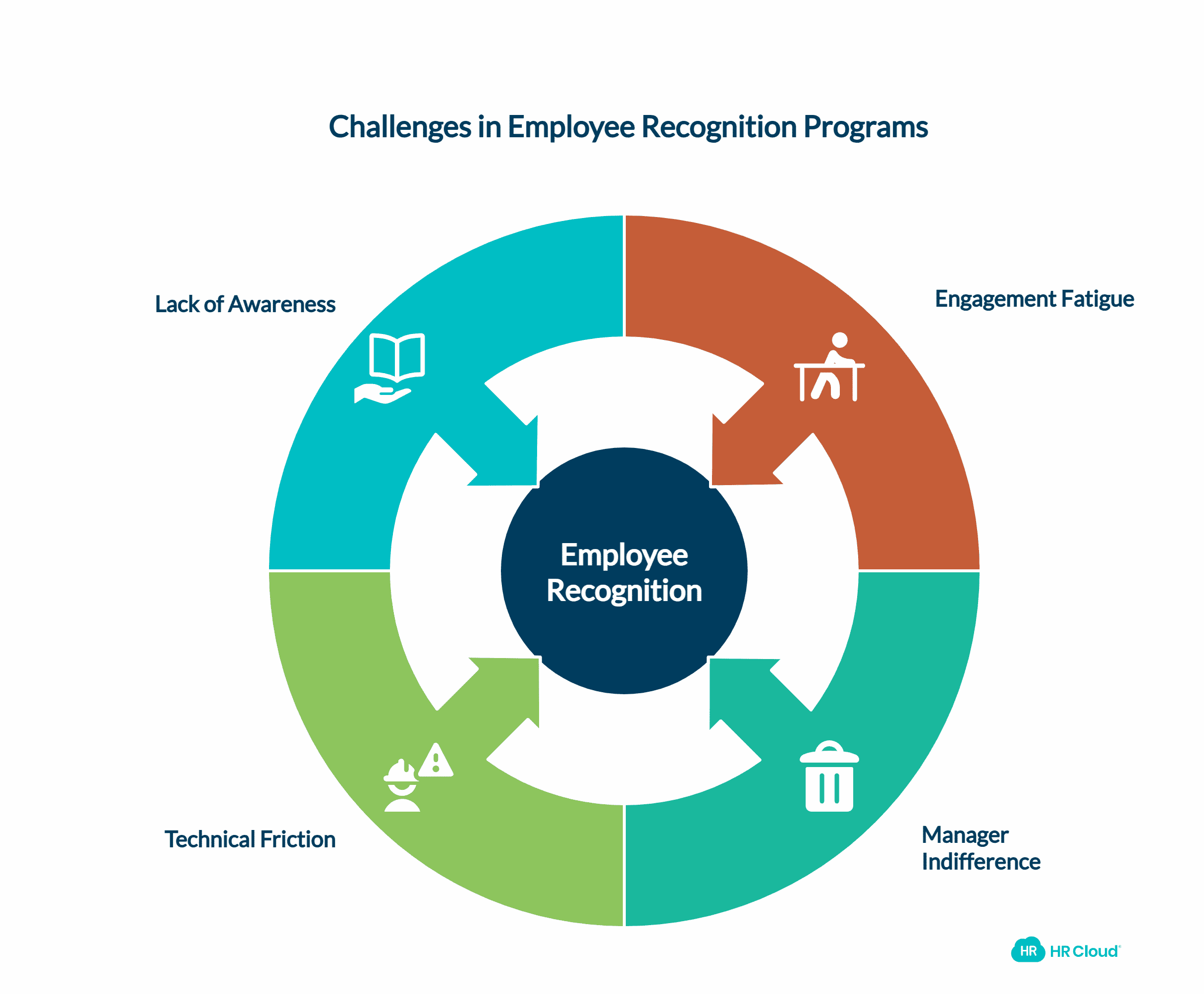
Low Adoption and Engagement Fatigue
You launched with fanfare. Participation soared initially. Then it dropped. Three months later, the same 20% of employees give 80% of recognition. Sound familiar?
Low adoption stems from predictable causes:
Lack of awareness: Employees forgot that the program exists. Solution: Regular reminders through multiple channels. Integrate recognition into existing meetings. Make it visible through intranet placement and Slack integrations.
Perceived irrelevance: People don't see how recognition applies to their role. Solution: Role-specific training showing relevant examples. Manufacturing floor workers need different recognition approaches than remote software developers.
Technical friction: Platform frustrates users. Solution: Ruthlessly simplify workflows. Remove unnecessary steps. Improve mobile experience. Test with actual users regularly.
Manager indifference: When managers don't champion recognition, teams don't participate. Solution: Manager accountability through metrics. Include recognition activity in performance evaluations. Celebrate managers whose teams show strong participation.
Engagement fatigue: The novelty wore off. Solution: Refresh campaigns every 8-12 weeks with new themes, updated rewards, gamification elements, and spotlight stories.
Address low adoption through targeted interventions rather than company-wide nagging. Identify low-participation departments. Meet with their leaders. Understand barriers. Co-create solutions.
Recognition Gaming and Superficial Praise
Points systems invite gaming. Employees give meaningless recognition to earn points. Friends trade recognition. Quality deteriorates.
Warning signs include sudden spikes in recognition from specific individuals, reciprocal recognition patterns (quid pro quo exchanges), generic messages with no specific details, and recognition clustering around reward redemption periods.
Mitigation strategies include caps on daily or weekly recognition giving, varying point values based on message quality, requiring written explanations beyond badge selection, peer or manager review for high-value recognitions, and machine learning flagging suspicious patterns.
But don't overreact to minor gaming. Some reciprocity is natural and healthy. Focus on egregious abuse rather than policing every exchange.
Address gaming through culture rather than rules alone. When leadership models authentic recognition, employees follow. When generic recognition gets less visibility than specific recognition, quality improves organically.
Uneven Participation Across Teams
Some departments embrace recognition enthusiastically. Others barely participate. This creates cultural divides and equity concerns.
Root causes vary. Department A might have a recognition champion manager, while Department B has a skeptical leader. One team works closely in-office while another is distributed remotely. Certain roles generate more visible achievements.
Diagnosis requires investigation. Review participation data by department. Interview low-participation teams. Identify specific barriers—technical, cultural, or structural.
Interventions might include assigning department-specific ambassadors, targeted training for low-participation managers, team-based recognition challenges creating friendly competition, or recognition prompts specifically designed for less visible roles.
Consider department-specific incentives. "First department to reach 90% participation wins team lunch" creates motivation through competition and shared rewards.
Integration and Technical Issues
Technology fails. Integrations break. Mobile apps crash. These technical issues undermine confidence and participation.
Common technical challenges include SSO authentication problems, HRIS sync failures, mobile app performance issues, notification overload or absence, and reward redemption complications.
Prevent issues through thorough testing before launch, gradual rollout identifying problems early, dedicated technical support during launch periods, and rapid response to reported issues.
When problems occur, communicate transparently. "We're aware that recognition notifications aren't working properly. Our team is resolving this. We'll update you by end of day." Honesty builds trust even when technology disappoints.
Maintain direct relationships with platform vendors. Escalation paths for critical issues prevent minor problems from becoming major crises.
Cultural Resistance and Skepticism
Some employees view recognition programs cynically. "Corporate trying to make us feel good instead of paying us more." "Another HR initiative that'll die in three months." "Recognition feels fake."
This skepticism isn't unreasonable. Many organizations launch programs poorly, let them wither, then launch new ones without acknowledging previous failures.
Address skepticism through transparency and authenticity. Acknowledge past program failures if relevant. Explain why this time differs. Show the business case honestly—recognition correlates with retention, engagement, and performance. It supplements rather than replaces fair compensation.
Give skeptics space. Don't force participation. Let early adopters demonstrate value. Peer influence converts skeptics more effectively than management mandates.
Share data regularly. "Since launching recognition three months ago, turnover in participating teams dropped 15%. Engagement scores increased 12 points. Here's what employees are saying..." Evidence overcomes skepticism better than cheerleading.
Some resistance reflects deeper cultural issues—lack of trust, poor leadership, unfair compensation. Recognition programs can't fix fundamental organizational dysfunction. Address root causes before expecting recognition initiatives to succeed.
How Workmates Helps Mitigate These Challenges
Workmates addresses common adoption challenges through thoughtful design and comprehensive features.
Reducing technical friction: The platform's mobile-first design and intuitive interface minimize the clicks required to give recognition. Employees don't need training manuals—the experience feels natural.
Governance features: Built-in controls prevent gaming without creating bureaucracy. Configurable approval workflows, spending limits, and audit trails provide oversight when needed.
Admin visibility: Comprehensive dashboards show participation patterns immediately. Low adoption in specific departments triggers alerts, enabling proactive intervention before problems compound.
Integration reliability: Workmates' proven integrations with major HRIS and communication platforms reduce technical issues through battle-tested connections rather than experimental APIs.
Engagement tools: The platform includes features specifically designed to maintain momentum—customizable recognition campaigns, notification systems keeping recognition visible, analytics showing individual and team progress, and reward catalogs adaptable to changing preferences.
Client feedback consistently highlights successful challenge navigation. As one organization noted: "After implementing Workmates by HR Cloud, we saw a 98% adoption rate across the workforce"—far exceeding typical recognition program participation.
Sample Use Cases and Implementation Scenarios
Scenario: Mid-Market Technology Firm Launch
A 450-person software company recognized engagement declining and turnover increasing, particularly among engineers and customer success teams. Exit interviews repeatedly mentioned employees feeling undervalued despite competitive compensation.
Leadership decided to pilot peer-to-peer recognition across three teams: a 12-person engineering squad, an 8-person customer success pod, and a 15-person product management group. These teams represented different work styles—heads-down technical work, customer-facing communication, and cross-functional collaboration.
Implementation approach: They configured the platform with five recognition badges aligned to company values: Innovation, Customer Obsession, Collaboration, Ownership, and Bias for Action. Points accumulated toward gift cards and experiences ranging from coffee shops to adventure activities.
Training consisted of 20-minute lunch-and-learn sessions demonstrating recognition mechanics and showcasing examples of effective appreciation. Managers committed to giving at least two recognitions weekly and prompting their teams through Slack.
Results after 8 weeks:
-
87% of pilot participants gave at least one recognition
-
Average 3.2 recognitions per employee per month
-
Engagement pulse survey scores increased 14 points in pilot teams versus 2 points company-wide
-
Zero turnover in pilot teams versus 4 departures in comparable non-pilot teams
-
Qualitative feedback overwhelmingly positive—"Finally feels like we appreciate each other"
Challenges encountered: The engineering team initially struggled with recognition frequency. Developers worked independently, making peer contributions less visible. The solution involved specific prompts: "Who helped you debug code this week?" "Whose code review improved your work?" These targeted nudges increased engineering recognition from 1.4 to 2.8 per person monthly.
Customer success team experienced recognition inflation—generic "great job!" messages. A manager discussion emphasizing specificity and modeling detailed recognition corrected this within two weeks.
Company-wide rollout: Based on pilot success, the company rolled out to all 450 employees over three weeks. They replicated pilot training approaches, established department ambassadors, and launched with "Recognition Week"—a challenge to reach 1,000 company-wide recognitions (achieved day four).
Six months post-launch, turnover dropped 22% compared to the prior six months. Employee engagement survey scores increased 11 points. The recognition program directly contributed to these improvements according to qualitative feedback.
Sector-Specific Customization: Healthcare Implementation
Healthcare organizations face unique recognition challenges. Shift-based work schedules limit face-to-face interaction. Nurses and clinical staff lack desk time. High-stress environments make appreciation especially important yet easily forgotten.
A 600-employee hospital system implemented peer recognition with healthcare-specific adaptations:
Mobile-first mandate: Given deskless workers, mobile app functionality received primary focus. Recognition needed to work flawlessly on smartphones with offline capability for areas with poor connectivity.
Shift-specific features: Recognition campaigns targeted shift transitions—"Recognize someone from the previous shift who set you up for success." This connected teams that rarely interacted.
Safety and compliance focus: Custom recognition badges for safety adherence, infection prevention, patient satisfaction, and regulatory compliance reinforced clinical priorities.
Quick interactions: The platform enabled recognition in under 30 seconds—critical for time-pressed healthcare workers.
Results: The hospital system reported 30% improvement in retention within nursing staff, 18% increase in patient satisfaction scores (attributed partly to improved staff morale), and significant improvement in safety protocol adherence.
Clinical staff feedback emphasized feeling valued for the first time in years. One nurse commented, "Night shift rarely gets noticed. Now, when we do extra to prepare for day shift, they actually acknowledge it. Makes the hard days easier."
Scaling from Pilot to Global Rollout
A multinational manufacturing company with 3,200 employees across 14 countries faced different scaling challenges.
Localization requirements: Recognition needed translation into six languages. Reward catalogs required region-specific options—gift cards available in Brazil differed from those in Germany.
Cultural sensitivity: Recognition norms vary dramatically across cultures. Some cultures embrace public recognition; others prefer private acknowledgment. The platform needed flexibility accommodating these preferences.
Time zone challenges: Global companies never sleep. Recognition campaigns needed staggered timing so "Recognition Friday" didn't occur Thursday night or Saturday morning depending on location.
Compliance variations: Different countries impose different data privacy regulations. The system required GDPR compliance for European employees and separate data handling for other regions.
Implementation approach: The company piloted in three regions simultaneously—North America, Europe, and Asia-Pacific. This revealed region-specific challenges early. European employees wanted stronger privacy controls. Asian teams preferred less public recognition. North American workers embraced gamification enthusiastically.
Based on pilot learning, the company created localization playbooks for each region, trained regional HR teams as administrators, and established regional champion networks.
Rollout timeline: Rather than flipping a switch globally, they rolled out region-by-region over six months. This allowed continuous learning and iteration. Lessons from North America improved European launch. Asian rollout benefited from both previous implementations.
Results: Eighteen months post-launch, the company maintained 73% global participation—remarkable for a multinational. Recognition patterns showed healthy cross-regional appreciation, strengthening global cohesion. Turnover decreased 16% company-wide with strongest improvements in regions that had faced retention challenges previously.
Templates and Resource Appendices
Template D: Survey / Feedback Template Post-Launch
Recognition Program Feedback Survey
Thank you for participating in our peer recognition program! Your feedback helps us improve.
-
1. How often do you give recognition to colleagues?
○ Multiple times per week
○ Once per week
○ 2-3 times per month
○ Once per month
○ Less than once per month
○ Never
-
2. How often do you receive recognition?
○ Multiple times per week
○ Once per week
○ 2-3 times per month
○ Once per month
○ Less than once per month
○ Never
-
3. How easy is the recognition platform to use?
○ Very easy
○ Somewhat easy
○ Neutral
○ Somewhat difficult
○ Very difficult
4. Which method do you primarily use to give recognition?
○ Mobile app
○ Desktop/web browser
○ Slack integration
○ Teams integration
○ Haven't given recognition yet
-
5. How satisfied are you with the reward options available?
○ Very satisfied
○ Satisfied
○ Neutral
○ Dissatisfied
○ Very dissatisfied
-
6. The recognition I receive feels authentic and meaningful.
○ Strongly agree
○ Agree
○ Neutral
○ Disagree
○ Strongly disagree
-
7. The recognition program has positively impacted our team culture.
○ Strongly agree
○ Agree
○ Neutral
○ Disagree
○ Strongly disagree
8. What do you value most about the recognition program? (Open-ended)
9. What frustrates you about the recognition program? (Open-ended)
10. What would make you give recognition more frequently? (Open-ended)
11. What new features or improvements would you suggest? (Open-ended)
12. Any other feedback or comments? (Open-ended)
Thank you for your input! We review this feedback monthly and make improvements based on what you tell us.
Template E: KPI Dashboard Outline
Recognition Program KPI Dashboard
PARTICIPATION METRICS
-
% employees giving at least 1 recognition (target: 70-80%)
-
% employees receiving at least 1 recognition (target: 60-70%)
-
Total recognitions given this period
-
Recognitions per employee (average)
-
Trend: recognition volume week-over-week
ENGAGEMENT QUALITY
-
Average recognition message length
-
% recognitions linked to company values
-
% recognitions with responses/engagement
-
Specificity score (automated text analysis)
DISTRIBUTION & EQUITY
-
Recognition by department (participation %)
-
Recognition by role level (ensure equity)
-
Recognition by location (for multi-site orgs)
-
Top givers (celebrate generosity)
-
Top receivers (celebrate contributions)
-
Cross-functional recognition frequency
PROGRAM HEALTH
-
Daily/weekly active users
-
Mobile vs. desktop usage split
-
Recognition response time (hours from action to recognition)
-
Repeat participant rate (gave recognition multiple times)
REWARDS & REDEMPTION
-
Points earned this period
-
Points redeemed this period
-
Redemption rate %
-
Most popular rewards
-
Average time to redemption
BUSINESS IMPACT
-
Correlation: recognition frequency × engagement scores
-
Turnover rate: high-recognition employees vs. low-recognition
-
Participation rate × retention rate correlation
-
Department participation × department engagement scores
MANAGER EFFECTIVENESS
-
Manager recognition activity (giving frequency)
-
Team participation rate by manager
-
Manager training completion rate
-
Recognition quality score by manager's team
ALERTS & ACTION ITEMS
-
Departments below 50% participation (investigate)
-
3 consecutive weeks of declining activity (intervention needed)
-
High redemption backlog (reward catalog issues?)
-
Unusual recognition patterns (potential gaming)
MONTHLY COMPARISON
-
Current month vs. prior month (all metrics)
-
Current quarter vs. prior quarter
-
Year-over-year comparison
Notes:
- Update weekly at minimum
- Share highlights monthly with leadership
- Drill down into problem areas immediately
- Celebrate wins publicly
Glossary of Terms
Badges: Digital icons representing specific types of recognition (e.g., "Collaboration Champion," "Innovation Star"). Employees select relevant badges when giving recognition to categorize contributions.
Points: Numerical values earned through receiving recognition, redeemable for rewards. Point systems gamify recognition and provide tangible appreciation.
Kudos: Informal term for peer-to-peer recognition, often used interchangeably with recognition or appreciation.
Recognition Feed: Central social stream displaying recent recognition activity across the organization, similar to social media feeds.
Leaderboards: Rankings showing top recognition givers or receivers, used as motivational and visibility tools.
Recognition Champions/Ambassadors: Employees designated to promote recognition culture, answer questions, and drive adoption within their departments.
Values Alignment: Linking recognition to specific organizational values, reinforcing cultural priorities through appreciation.
Milestone Recognition: Automated or manual acknowledgment of significant events like work anniversaries, project completions, or certifications.
Cross-functional Recognition: Appreciation given between employees from different departments, strengthening organizational cohesion.
Recognition Inflation: Excessive generic praise that diminishes recognition value and authenticity.
Recognition Gaming: Exploiting recognition systems for personal gain rather than authentic appreciation.
Redemption Catalog: Curated selection of rewards available for earned recognition points.
Participation Rate: Percentage of employees actively giving or receiving recognition within a specific timeframe.
Sentiment Analysis: Automated evaluation of recognition message tone and authenticity using natural language processing.
Conclusion and Next Steps
Summary of Key Success Levers
Peer-to-peer recognition transforms organizational culture, but success demands more than installing software. The difference between thriving programs and abandoned initiatives comes down to execution fundamentals.
Strategic planning precedes implementation. Organizations that define clear objectives, establish governance frameworks, and secure stakeholder buy-in before launching experience dramatically higher success rates. Recognition programs aren't HR projects—they're business initiatives requiring executive commitment.
Platform selection shapes outcomes. The right technology disappears into workflows, making recognition effortless. Poor platforms create friction that kills adoption regardless of cultural readiness. Prioritize integration capabilities, mobile accessibility, and analytics depth over flashy features.
Phased rollouts reduce risk. Pilots surface challenges when stakes remain low. Learning from 50 employees costs less than discovering problems after company-wide deployment.
Sustained adoption requires active management. Initial enthusiasm fades without ongoing attention. Refresh campaigns, new rewards, gamification elements, and visible leadership modeling maintain momentum over years, not months.
Measurement proves value and guides iteration. Track participation rigorously, monitor distribution equity, correlate recognition with business outcomes, and gather qualitative feedback continuously. Data transforms recognition from feel-good initiative into strategic advantage.
The organizations seeing strongest results share common characteristics. Leadership models recognition behavior consistently. Managers receive training and accountability. Recognition connects explicitly to company values. Platforms integrate seamlessly into existing workflows. Programs evolve based on feedback and metrics.
Studies suggest companies with strong recognition programs may see 31% lower turnover, 23% higher profitability, and employees who are 5x more likely to feel valued. These aren't aspirational goals—they're achievable outcomes when implementation follows proven frameworks.
Moving Forward: Your Recognition Journey
Where does your organization stand today? Perhaps you're just beginning to explore peer recognition possibilities. Maybe you piloted unsuccessfully previously and need fresh approaches. Or you're running basic recognition but seeking deeper impact.
Wherever you start, the path forward involves concrete steps.
For organizations exploring recognition programs: Begin with cultural assessment. Survey employees about current appreciation frequency and satisfaction. Interview managers about recognition barriers. Analyze turnover patterns and exit interview feedback. This baseline data shapes your business case and implementation approach.
For organizations ready to pilot: Form a cross-functional steering committee representing diverse perspectives. Define 2-3 specific, measurable objectives. Select pilot teams strategically. Choose platform partners emphasizing integration, analytics, and support quality. Plan comprehensive but concise training. Establish feedback mechanisms from day one.
For organizations with existing programs needing revitalization: Audit current state honestly. What's working? What's broken? Why did participation decline? Survey employees and managers about barriers. Often, simple fixes—better mobile experience, refreshed rewards, targeted manager training—reignite stagnant programs.
For organizations seeking to scale: Document what works locally before expanding. Create playbooks encoding successful practices. Train regional champions. Adapt globally while respecting cultural differences. Invest in analytics infrastructure supporting data-driven decisions across locations.
The Business Case for Action
Delaying recognition initiatives carries real costs. Every quarter without effective recognition programs, talented employees leave for competitors who appreciate them. Engagement remains suboptimal. Productivity suffers. Culture stagnates.
The replacement cost for a typical employee ranges from 50-200% of annual salary depending on role. Organizations save $3,400 per employee annually through turnover reduction alone. If your company employs 500 people with 15% annual turnover, preventing just 20% of those departures saves $250,000+ annually.
Beyond retention, recognition drives engagement which drives performance. Highly engaged teams generate 21% higher profitability. Even modest engagement improvements translate to significant business impact.
The investment? Recognition platforms cost $2-8 per employee monthly. Reward budgets add $25-100 per employee annually. Implementation time requires 2-4 weeks. Training demands 1-2 hours per employee. These investments pale compared to turnover costs and engagement deficits.
Ready to transform how your organization appreciates contributions? Schedule a demo of Workmates to see how comprehensive recognition, seamless integrations, and powerful analytics create cultures where employees thrive.
Building Your Recognition Task Force
Successful implementation requires dedicated focus. Consider forming a recognition task force responsible for program launch and ongoing management.
Ideal task force composition includes:
-
Executive sponsor: Senior leader providing resources and removing barriers
-
HR lead: Program administrator managing platform and training
-
IT representative: Handling integrations and technical requirements
-
Communications specialist: Creating launch campaigns and ongoing messaging
-
Department representatives: Champions from across the organization bringing diverse perspectives
-
Analytics lead: Tracking metrics and generating insights
This group meets weekly during implementation, then monthly for ongoing management. They own decision-making around program evolution, troubleshoot adoption challenges, celebrate successes, and maintain accountability.
Leadership Pilot Approach
Before company-wide rollout, consider leadership pilot approach. Executives and senior managers use the recognition platform first, recognizing each other and direct reports. This serves multiple purposes.
Leaders experience the platform firsthand, understanding strengths and friction points. They develop recognition habits before asking others to do so. Their participation creates immediate visibility—when the CEO recognizes contributions publicly, employees notice. Leadership piloting signals genuine commitment rather than delegated HR initiative.
After 4-6 weeks of leadership usage, expand to manager population, then company-wide. This cascade approach builds skills and culture top-down while gathering feedback at each level.
Iteration and Evolution
Recognition programs should evolve continuously. What works today may need adjustment tomorrow. Markets change. Workforce demographics shift. Remote work increases. Generational preferences differ.
Plan annual program reviews examining comprehensive data, gathering extensive feedback, benchmarking against external comparisons, and setting next year's objectives. These deep reviews complement quarterly check-ins and monthly metrics monitoring.
Don't treat recognition platforms as set-and-forget technology. Refresh reward catalogs quarterly. Introduce new recognition categories annually. Update training content. Test emerging features. Programs that evolve stay relevant and engaging.
The Cultural Transformation Ahead
Peer recognition programs ultimately represent cultural shifts more than technology deployments. You're building organizations where appreciation flows freely, contributions get acknowledged immediately, values get reinforced consistently, and employees feel genuinely valued.
This cultural transformation takes time. Initial adoption happens in weeks. Habit formation requires months. Deep cultural embedding takes years. But the compounding effects—retention improvements, engagement increases, performance gains—justify sustained commitment.
The workplace landscape continues evolving. Remote and hybrid work arrangements, generational workforce shifts, increased focus on employee experience, and competition for talent all make recognition more critical than ever.
Organizations building strong recognition cultures today position themselves advantageously for tomorrow's challenges. Employees who feel valued stay longer, perform better, and advocate enthusiastically. That competitive advantage compounds over time.
Your Next Actions
Start now. Waiting for perfect conditions means missing opportunities today.
This week: Form preliminary steering committee. Review this guide with key stakeholders. Assess current recognition practices informally.
This month: Conduct cultural readiness assessment. Define preliminary objectives and success metrics. Research platform options. Develop business case for executive presentation.
Next quarter: Select platform partner. Plan pilot approach. Train pilot participants. Launch pilot program.
Within six months: Evaluate pilot results. Refine based on learning. Roll out company-wide. Establish ongoing management cadence.
Recognition programs succeed when leaders commit genuinely, platforms integrate seamlessly, training prepares participants, metrics prove value, and programs evolve continuously.
The question isn't whether your organization should implement peer recognition. The evidence overwhelmingly supports recognition's impact on engagement, retention, and performance. The question is how quickly you can implement effectively to realize these benefits.
Your employees contribute remarkable work daily. Many contributions go unnoticed and unappreciated. Peer recognition changes that, creating workplaces where great work gets celebrated consistently by the people who see it firsthand.
Transform appreciation from occasional gesture into daily practice. Connect with the Workmates team to explore how peer recognition can strengthen your culture, reduce turnover, and drive measurable business results.
Frequently Asked Questions
What is peer-to-peer recognition and how does it differ from traditional recognition?
Peer-to-peer recognition enables employees to directly acknowledge each other's contributions without requiring manager approval or involvement. Unlike traditional top-down recognition that flows from leadership to employees, peer recognition creates horizontal appreciation where colleagues celebrate each other's work. This approach proves particularly effective because peers witness daily contributions that managers might miss. Research shows peer recognition is 35.7% more likely to positively impact financial results than manager-only recognition, making it a powerful complement to traditional acknowledgment methods.
How much does implementing a peer recognition program typically cost?
Recognition program costs vary based on organization size and feature requirements. Platform subscriptions typically range from $2-3 per employee monthly for basic systems to $10-15 per employee monthly for enterprise solutions with comprehensive features. Beyond platform costs, organizations should budget $25-100 per employee annually for reward redemption. Implementation requires training time (1-2 hours per employee) and administrative resources (0.25-0.5 FTE for 500-1000 employees). Companies spending 1% or more of payroll on recognition achieve 79% higher success rates in reaching business goals, providing useful budget guidance. Most organizations see positive ROI within 12-18 months through retention improvements alone.
How do you prevent recognition gaming or employees abusing the points system?
Recognition gaming—where employees give meaningless recognition solely to earn points—represents a real concern that thoughtful design mitigates. Effective prevention strategies include capping daily or weekly recognition limits, requiring written explanations beyond badge selection, varying point values based on message specificity and quality, implementing peer or manager review for high-value recognitions, and using analytics to flag suspicious patterns like excessive reciprocal recognition. However, avoid over-policing minor reciprocity, which occurs naturally in healthy recognition cultures. The most powerful anti-gaming mechanism remains cultural rather than technical—when leadership models authentic recognition and generic praise receives less visibility than specific appreciation, quality improves organically without creating bureaucratic approval processes that stifle spontaneity.
What recognition frequency should organizations target?
Optimal recognition frequency balances consistency with authenticity. Most successful programs target 2-4 recognitions per employee per month, with 70-80% of employees giving at least one recognition and 60-70% receiving recognition within each month. Studies show 43% of employees prefer being recognized at least once per week, while immediate recognition boosts effectiveness by 30% compared to delayed acknowledgment. However, forced recognition kills authenticity—employees should give recognition when they genuinely observe contributions worth celebrating, not because quotas demand it. Weekly team rituals allocating 5-10 minutes for recognition shout-outs help normalize appreciation without mandating specific frequencies. The goal involves making recognition consistent and timely while maintaining genuine sentiment behind each acknowledgment.
How long does it take to implement a peer recognition program?
Implementation timelines vary based on organization size and complexity. Workmates typically requires 2-4 weeks for full implementation, significantly faster than competitors requiring 8-12 weeks. A typical phased approach includes 1-2 weeks for platform configuration and integration setup, 4-8 weeks for pilot program with selected teams, 2-3 weeks for pilot evaluation and refinement, and 2-4 weeks for company-wide rollout. Organizations moving more deliberately might extend pilot phases or implement department-by-department over several months. While technical setup happens relatively quickly, cultural adoption—building recognition habits and embedding appreciation into daily workflows—takes 3-6 months. Full cultural transformation where recognition becomes deeply ingrained organizational practice requires 12-18 months of sustained effort and ongoing management.
Should recognition be public or private?
Most recognition benefits from public visibility that reinforces cultural norms and shows what contributions get valued. Public recognition creates social proof encouraging similar behaviors, makes appreciation visible to broader teams, reinforces company values organization-wide, and celebrates contributions others might not see. However, certain situations warrant private recognition including sensitive personal challenges where colleagues provided support, developmental feedback paired with acknowledgment, contributions involving confidential projects, or when recipients prefer privacy. Effective platforms like Workmates provide flexibility allowing givers to choose visibility based on context. As general guidance, approximately 80-90% of recognition should be public while 10-20% remains private. The key involves empowering employees to make appropriate judgments rather than mandating one approach universally.
How do you ensure remote and deskless workers participate equally?
Remote and deskless workers often receive less recognition than office-based employees unless organizations implement intentional inclusion strategies. Workmates addresses this through mobile-first design specifically for distributed and frontline workforces, enabling full recognition functionality from any smartphone. Critical features for these populations include offline capability for poor connectivity areas, push notifications keeping recognition visible, integration with communication tools remote workers already use, and recognition workflows taking under 30 seconds to complete. Beyond technology, cultural practices matter—creating recognition campaigns specifically highlighting remote contributions, training managers to actively recognize distributed team members, establishing rituals connecting across shifts and locations, and monitoring analytics to identify participation gaps requiring intervention. Healthcare organizations using these approaches report participation rates among clinical staff matching or exceeding office-based employees.
What metrics best demonstrate recognition program ROI?
Proving recognition ROI requires connecting program activity to business outcomes through multiple metrics. Primary indicators include turnover rate comparison between highly recognized employees versus low-recognition employees, voluntary turnover percentage changes before and after implementation, engagement survey score correlations with recognition frequency, and retention cost savings calculations. Organizations typically save $3,400 per employee annually through reduced turnover alone. Additional metrics include participation rates across departments, recognition frequency trends, sentiment analysis of recognition messages, correlation between recognition and performance metrics, and qualitative feedback from engagement surveys and exit interviews. Comprehensive platforms like Workmates provide analytics showing these connections, enabling data-informed decisions about program effectiveness. Most organizations see measurable ROI within 12-18 months, with companies implementing strong recognition programs experiencing 31% lower voluntary turnover and 23% higher profitability.
How do you handle low participation or declining engagement over time?
Recognition programs commonly experience initial enthusiasm followed by declining participation—a predictable pattern with preventable causes. Low adoption typically stems from lack of ongoing awareness, perceived irrelevance to specific roles, technical friction in platforms, manager indifference, or simple engagement fatigue. Address low participation through targeted interventions rather than company-wide nagging. Identify low-participation departments and meet with leaders to understand specific barriers. Common solutions include regular multi-channel reminders integrated into existing communications, role-specific training showing relevant examples, ruthless simplification of recognition workflows, manager accountability through performance metrics, and refresh campaigns every 8-12 weeks featuring new themes, updated rewards, gamification elements, and spotlight success stories. Analytics identifying declining trends early enable proactive intervention before participation collapses. When managers champion recognition actively and platforms make giving recognition effortless, sustained adoption becomes achievable even years after initial launch.
Can peer recognition programs work in highly regulated industries like healthcare or finance?
Peer recognition programs absolutely work in regulated industries, though they require additional considerations around compliance, security, and privacy. Healthcare organizations particularly benefit from recognition given high-stress environments and retention challenges. Critical requirements for regulated sectors include SOC 2 Type II certification demonstrating security controls, GDPR and CCPA adherence for data privacy, role-based access controls, comprehensive audit trails, and secure data storage and transmission. Workmates follows best-in-class security practices while enabling recognition across distributed clinical teams. Beyond technical compliance, these industries benefit from recognition badges tied to sector-specific priorities—safety adherence, infection prevention, regulatory compliance, or quality standards. Healthcare clients report 30% retention improvements among nursing staff and 18% increases in patient satisfaction scores partially attributed to improved morale through consistent recognition. The key involves selecting platforms built for enterprise compliance requirements rather than consumer-grade tools lacking necessary security infrastructure.
What's the best way to integrate recognition with existing HRIS and communication tools?
Seamless integration proves essential for recognition program success because standalone systems fail to embed into daily workflows. Recognition platforms should sync automatically with HRIS systems ensuring accurate employee data, eliminating manual updates, enabling role-based recognition, and connecting recognition to other HR processes. Workmates offers turnkey integrations with leading platforms including ADP, UKG, Workday, Paycor, and Paylocity, providing single sign-on, automated data synchronization, and unified employee experience. Communication tool integration matters equally—most work happens in Slack or Microsoft Teams, so recognition should live where employees already collaborate. Look for native integrations allowing recognition without leaving these platforms, notifications appearing in relevant channels, and bot functionality providing prompts and reminders. Calendar integration enables automated milestone recognition for birthdays and work anniversaries. Mobile apps ensure deskless workers access full functionality. When evaluating platforms, prioritize integration depth over feature lists—the best features prove useless if employees must leave their workflow to access them.
How do you customize recognition programs for different company values and cultures?
Generic recognition programs miss opportunities to reinforce unique organizational identity. Effective customization starts with values mapping—identifying your 4-7 core values and creating recognition badges or categories for each. If "innovation" drives decisions, create innovation-specific recognition. If "customer obsession" matters most, make that explicitly recognizable. Beyond values, consider industry-specific contributions worth celebrating. Manufacturing organizations might emphasize safety achievements and production milestones. Technology companies might highlight code quality and technical mentorship. Professional services firms might focus on client impact and knowledge sharing. Workmates enables customization through flexible badge systems, configurable point values, branded interfaces, and adaptable workflows reflecting unique cultures. Reward catalogs should align with employee preferences varying by demographics, geography, and culture. Survey employees about desired rewards rather than assuming standard options work universally. Training content and recognition examples should reflect your specific environment—showing relevant scenarios employees encounter daily rather than generic workplace situations. This customization transforms recognition from generic appreciation into cultural reinforcement that strengthens organizational identity.
What role should managers play in peer recognition programs?
Managers serve as critical catalysts for peer recognition success despite programs being peer-driven rather than manager-controlled. 72% of employees say recognition from their manager has the most impact on their engagement, making manager participation essential. Key manager responsibilities include modeling recognition behavior by regularly acknowledging both direct reports and peers across the organization, encouraging team participation through prompts and reminders without mandating activity, allocating meeting time for recognition discussions, celebrating recognition milestones publicly, addressing low participation constructively, and providing feedback on recognition quality and specificity. However, only 22% of managers report feeling equipped to understand how to acknowledge employees, highlighting the critical need for manager-specific training on recognition best practices. Hold managers accountable through metrics tracking their team's participation rates, include recognition championing in performance evaluations, and provide resources making their role easier rather than adding administrative burden. When managers champion recognition authentically, their teams follow—creating cultural momentum that spreads organization-wide.
How do peer recognition programs affect employee retention?
Recognition directly impacts retention through multiple mechanisms that address why employees leave. 66% of employees say they would leave their job if they didn't feel appreciated, making lack of recognition a primary turnover driver. Studies suggest companies with strong recognition programs may see 31% lower voluntary turnover, translating to substantial cost savings and organizational stability. Recognition improves retention by increasing employee engagement and emotional connection to work, making employees feel valued by colleagues and leadership, reinforcing positive behaviors and contributions, creating social bonds that increase belonging, and demonstrating that the organization notices and appreciates efforts. The retention impact compounds over time—employees who feel consistently recognized develop deeper organizational commitment than those experiencing sporadic or absent appreciation. Organizations save $3,400 per employee annually through reduced turnover when implementing effective recognition programs. For a 500-person company with 15% annual turnover, reducing departures by just 20% through recognition saves over $250,000 annually while preserving institutional knowledge and team continuity that money can't buy.
This comprehensive implementation guide equips HR leaders and organizational decision-makers with practical frameworks, proven strategies, and ready-to-use templates for launching peer-to-peer recognition programs that deliver measurable business results. For personalized consultation on implementing recognition programs tailored to your unique organizational context, connect with the Workmates team to explore how comprehensive recognition technology combined with strategic implementation support creates cultures where employees feel genuinely valued and choose to stay.

Keep Reading
Embracing Diversity: Recognizing Different Cultures in the Workplace
Workplaces today reflect the incredible diversity of the world around us. People bring
A Quick Guide to Manager-Led Recognition Training: Turn Your Leaders into Recognition Champions (Free Launch Checklist Inside)
Here is a belief that's costing organizations billions: that employee recognition is HR's
Employee Recognition for Hybrid Workplaces: Equity and Inclusion Strategies
Last week of the quarter. You're reviewing your quarterly recognition reports, and
Like What You Hear?
We'd love to chat with you more about how HR Cloud® can support your business's HR needs. Book Your Free Demo

Build a Culture of Recognition. Boost Engagement. Guaranteed.
Workmates empowers employees to stay informed, connected, and appreciated—whether they’re on the front line, in the office, or remote. Recognition drives 12x higher engagement.Trusted by industry leaders in every sector




Cut Onboarding Costs by 60%.
Take the confusion and follow-ups out of onboarding with automated workflows, digital forms, and structured portals—so new hires ramp faster 3X quicker.Trusted by industry leaders in every sector




